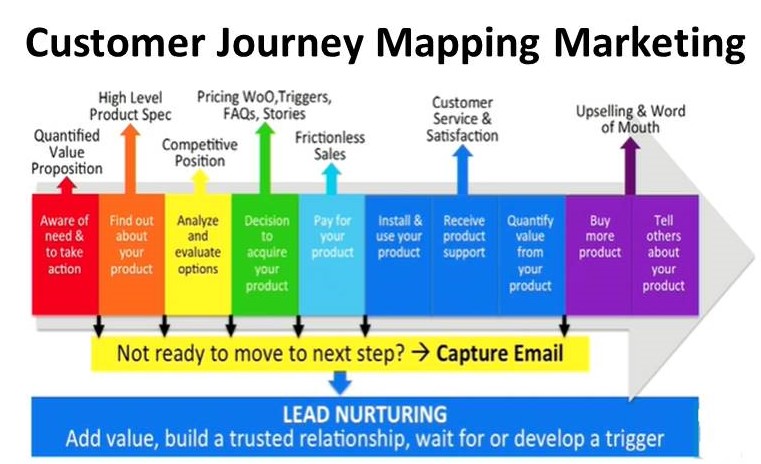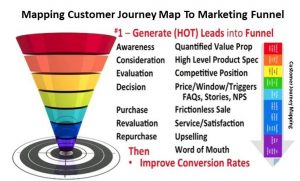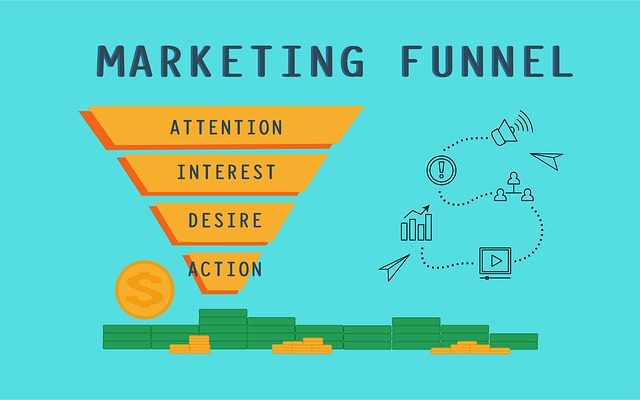We will be addressing each stage of the customer journey map when we look at marketing. This helps in on how to improve marketing funnel.
1) Aware of need & to take action
The first step that we look at in marketing is how do you know that your customer is aware of a need and is ready to take some action? The document you’re going to use here and deal with your customer is going to be your quantified value proposition? For example, if you asked your customer the question, do you have a problem sleeping at night?
The customer is either going to go yes or no, and that problem statement/identification is where a quantified value proposition comes in. Your quantified value proposition may say, do you have a problem sleeping at night? We have a solution that is organic, non-intrusive, and it creates an 80% increase in sleeping ability.
The reality is, your customer is either going to say I’m interested, or I’m not. That is the purpose of the quantified value proposition.
2) Find out about your product
Then your customer is going to want to go, Okay, I’m interested, tell me more. This is where your high level product specification comes in. What is it and what are the features, functions and benefits of how it works?
3) Analyze and evaluate options
If they’re still interested at that point, they’re going to analyze and evaluate their options. This is where your competitive positioning comes in. Right off the bat, you’re going to give them the shorthand to show where you fit in the competitive landscape. They’re going to immediately recognize I could take zolpidem or Lunesta, which are all drugs, but here’s your solution, and it’s better than both of them.
4) Decision to acquire your product
They are going to go like okay; I’m really interested. Then there’s a decision to acquire your product. This is where your pricing framework, your windows of opportunity and triggers, your facts or your frequently asked questions, and your stories and your testimony all play in making a decision to acquire your product.
Your frequently asked questions is a great way to address the opposition or the obstacles that would come to people purchasing it, and do it in a touch less, human touch less way because the more people you engage in this process, the more it costs, the more expensive it is. Frequently asked questions is a great way to deal with people having questions or issues concerning your solution.
5) Pay for your product
When it comes to paying for the product, do you have a frictionless sales process? The last thing that a customer wants to do is wait to pay you money. Of course, does your internet system work? Is it easy to work through? I’ve seen some that are very difficult.
Going to a physical store and trying to pay for something, sometimes I wonder. I want to ask the people working behind the counter if this would be a great place to work if it wasn’t for the customers because it seems to inconvenience them. The last thing that a customer wants to do is have a lot of frictions in trying to pay for the product.
6) Install and use your product; receive product support; quantify value from your product
Then when we deal with things like installing and using the product, receiving product support and quantifying value from your product, we’re really dealing with customer service and satisfaction. That is the infrastructure we have to put together on how we relate to customer service and satisfaction.
7) Buy more products and tell others about your product;
Then ultimately buying more and telling others about it is an up-selling and word of mouth process.
We have all these processes that we go through in sales and marketing that are tied to the customer journey map. Here’s a picture of the customer journey map with all those pieces associated with it.

If people get stuck, and they don’t move forward in the process, somehow we’d like to capture their email or contact information, so that we can keep providing them with more information in a lead nurturing process. This is how to improve marketing funnel. How can we add value? How can we build a trusted relationship and then wait for or develop a trigger in a window of our opportunity to move them towards purchase?
Lead nurturing is a very important process and in the marketing campaign, we could call it a drip campaign. Adding value is the key here, and that they begin to trust you as a subject matter expert. If you keep adding value, they’re going to want to hear what you have to say. They’re going to come looking for you when it’s time to purchase because you’ve shown them that you’re an expert.
Map Customer Journey Map to Marketing Funnel
Let us put all this together with the sales and marketing funnel. We want to map the customer journey map to the marketing funnel.

In our first process there is the awareness, which is our quantified value proposition, where they consider the product that is our high level product specification, where they evaluate is our competitive position.
Their decision to purchase is where we use our prices, windows and triggers, stories, testimonies and Net Promoter Score. When they purchase, we want to have frictionless sales, when they re- evaluate, we want to have great service and satisfaction, then repurchase would be upselling and word of mouth.
The number one step is to generate hot leads into the funnel. Cold leads take longer to close; hot leads would be word of mouth. Remember, 92% of millennials are more likely to buy based on word of mouth, from their friends, and even 50% based on the word of mouth or the testimonies within the user experience that you track online.
Everything we’ve built up till now, we’re using and integrating into the marketing funnel in the process of mapping how to acquire a customer. Once we get them into the funnel, then the focus is to improve conversion rates, and here’s what’s so wonderful about this process. With the software capabilities that we have today and the way we set up our website, we can tell where people stop in the process.
They land on the website, but they don’t look at the high level product specification, that tells me the quantified value proposition didn’t touch them. They look at the high level product specification, but they don’t bother looking at the competitive positioning. That tells me that the high level product specification wasn’t what they were looking for.
They look at the competitive position, but they don’t actually make a decision and purchase. Maybe they’re off, it’s sitting in the shopping cart, and they’re checking out other people’s prices. The key is you know where they’re stuck, and you can work on something very specific through AB testing in different forms to get them unstuck. We have a very focused intervention to address the sales process. We move them through the conversion rates, and we nurture leads where people have not made the decision to buy. This is how to improve marketing funnel.
Traction Channels
When you launch your company, your greatest challenge is going to be traction; getting traction and making sales. We have got all of these things that you can look at blogs, podcasts, search, engine marketing, search engine optimization, content marketing, email marketing, viral marketing, all of these things are approaches that you can take.
The existing platforms that you can use are influencers, affiliates, experiential marketing, community building, testimonies and stories. You want to figure out which one of these traction channels work for. You’re going to find one works better than almost all the others; pick four or five of them, one should stand out, put all your energy into that traction channel. This is how to improve marketing funnel.
Engineering is marketing is an example where you build a product that serves your customer, and the solution comes back to you; you both benefit from it. Other channels include trade shows, speaking engagements, publicity, unconventional public relations stunts are things that people do crazy things to get attention. They’re great for starters. All of these things are different ways to create traction.
Summary
How to improve the marketing funnel involves mapping the customer journey to the marketing funnel, identifying where they’re stuck and then working on something very specific through AB testing in different forms to get them unstuck. It helps you to develop a very focused intervention to address the sales process, move them through the conversion rates, and nurture leads where people have not made the decision to buy.

